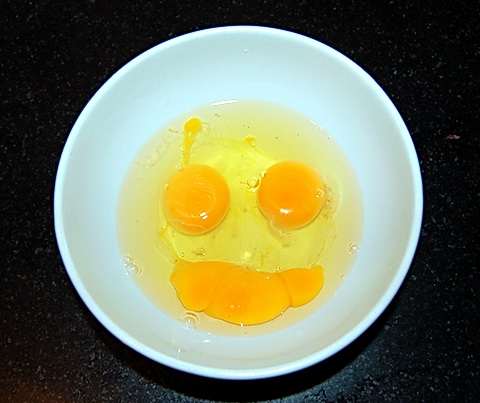
He made such a nice omelet: Leftover roast pork and cheese, topped with eggplant & meat sauce.
Category: Food
Mosquitoes Eating Fruit (Part 1 – Jackfruit)
In or new Thai house, we’ve noticed mosquitoes sucking moisture out of sponges around the sink area, or from damp towels or rags. I suppose this is normal behavior, but we never really noticed it until we lived in this house. The past year, we’ve started to notice them sucking on various fruits we leave out on the counters. I’ve decided to start recording these images because I feel there’s a greatly underestimated demand for knowing what mosquitoes that aren’t sucking blood are sucking.
In this case, it was jackfruit.
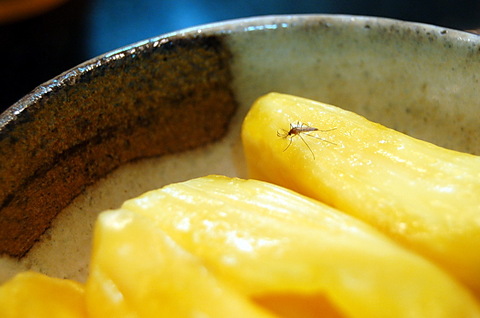
Click to see the entire Mosquitoes Eating Fruit Series.
Cornershop Kway Chap
Last week I visited at a noodle shop that I thought was new, but my coworker said it’s been around for a few years.
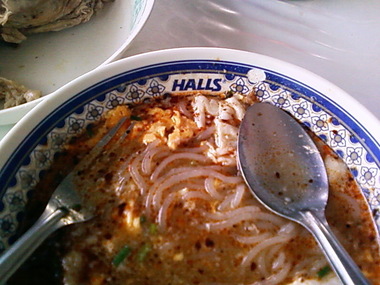
This is mainly what they sell, standard kway chap noodles served Vietnamese style in clear chicken stock with rice noodles of medium thickness (you can also get instant ramen served in kway chap stock).
This is opposed to the other style of kway chap popular in Thailand, the Chinese kind in brown stock with blood cubes, bamboo shoots, and spiral flat noodles (this Chinese kind is usually done very poorly in Thailand IMHO, but when done properly, with fresh ingredients and duck meat, can be very tasty).
A vital key to surviving in any given area over an extended period of time is knowing the secret menus of your favorite haunts. The secret menu of this place was somewhat amusing:
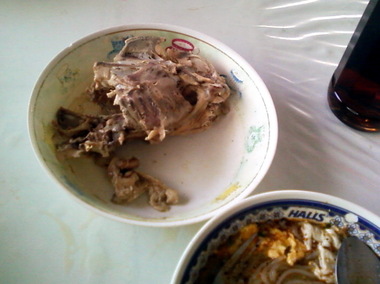
I loves me some chicken bones! (They use a bunch of these for the broth every day.)
Notes: This shop is located on Soi Srisawat between RMU and Spirit House Kway Chap, on the right side if headed away from RMU. Kway chap w/o egg 20 baht, w/egg 25 baht, chicken carcass 20 (25?) baht.
runs
Yesterday I got food poisoning for the first time in a couple years; it was probably a bad spot of ground pork or chicken I had for breakfast. I started feeling queasy in the late morning and had Nam pick me up after she picked up Max from a half-day at nursery school (we’re sharing the Cefiro until Nam stats working again in a couple weeks because the insurance ran out on my Crown and I figured I could hold off on re-insuring until we really need two cars again – this whole week she’s been dropping me off at school, dropping Max off at preschool, and I’ve been walking home). Luckily, Nam and Max didn’t get sick.
Some other crazy things happened yesterday in my fever state; I’ll get around to describing them later. In the meantime, I’m not nauseous today, but I can’t stray far from the bathroom.
Props to Kris
This Hainan Chicken recipe vid that my cousin Kris made yielded a meal so good, we won’t eat it outside anymore (there are tons of these chicken rice vendors in Thailand, but I’ve never had one as good as we made a few nights ago). I tried making a couple different sauces and they both turned out really well. Thanks, Kris!
I made a perfect salad today…
Tekito Salada:
- A bag of mixed lettuce Nam bought on sale yesterday
- Onion
- Bell pepper
- Thick-cut ham slices
- 2 processed cheese slices
Special Tekito Salada Topping:
- Canned tuna
- Kewpie mayo
- Spike seasoning
- Pepper
Tekito Salada Dressing:
- Balsamic vinegar
- Olive oil
- Salt
- Pepper
- Sesame seeds
* Note that tekito (??) means “whatever works” in Japanese.
Prepare and toss all of the Tekito Salada ingredients after dribbling on a suitable amount of Tekito Salada Dressing, then top with a scoop of Special Tekito Salada Topping. If your seasoning mojo is spot on, like mine was today, you will have created a perfect salad.
Possible improvements (if they happen to be in the fridge next time): Tomatoes, Borabu apples (or jicama), jerked cane frog powder
Vegetarians have it hard in Thailand
…and here’s the proof.
Note: The photo gallery above is pretty hardcore piercing/mutilation stuff.
Max loves bitter melon (bitter gourd)
How very, very strange. We’ve never heard of a child liking this stuff. Bitter melon is called mara in Thai, and nigauri in Japanese (goya in Okinawan). It’s much the same in both countries, although we’ve found the Japanese variant (the one used in famous Okinawan dishes such as chanpuru) to be more bitter and astringent. The Thai version is a paler green than the Japanese ones.
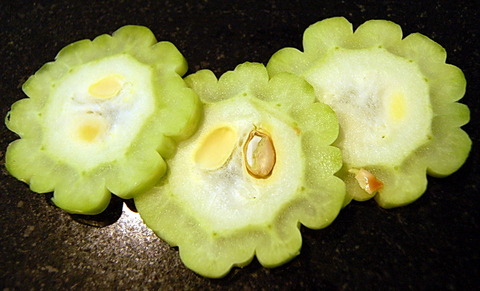
Basically, in all three cultures it is recognized as having beneficial medicinal properties (hypoglycemic effect and antioxidant activities). To be quite honest, the Japanese variety was too astringent for my taste; the ones we are getting here in Thailand (about 16 inches long and almost as thick as a baseball bat) are just bitter enough to be interesting but not overpowering. Nam likes the full smack-you-in-the-face flavor of the Japanese version. I’ve noticed that more girls than guys seem to like bitter melon, in Japan at least.
Nam made a nice soup with pressure-cooked pork short ribs and bitter melon tonight, and Max couldn’t stop eating it! We’re very happy and amazed that he often chooses sour/bitter foods over sweet ones. Sometimes it’s just mimicking behaviour, but other times he’s chosen, say, to lick a lemon multiple times even though it makes his face pucker up like an imploded fugu!
P.S. Only the darker outer ring of the melon is eaten, the pale inner flesh and seeds are thrown away.
lipton baracus

In Japanese, this specific position might be called a reverse inari-otoshi (falling inari). If you’ve ever seen an inarizushi up close, you may understand why. It’s usually performed on an unsuspecting high school friend who is sleeping face-up, and does not make you automatically hated among your peers, however disturbing the imagery might be (this is all hearsay; I didn’t even go to high school in Nippon).
Say it three times with me: Inariotoshi, inari-otoshi, ??????
That is your cultural baggage of the day; some things cannot be un-read.
(image from Cyanide and Happiness via Adam)
